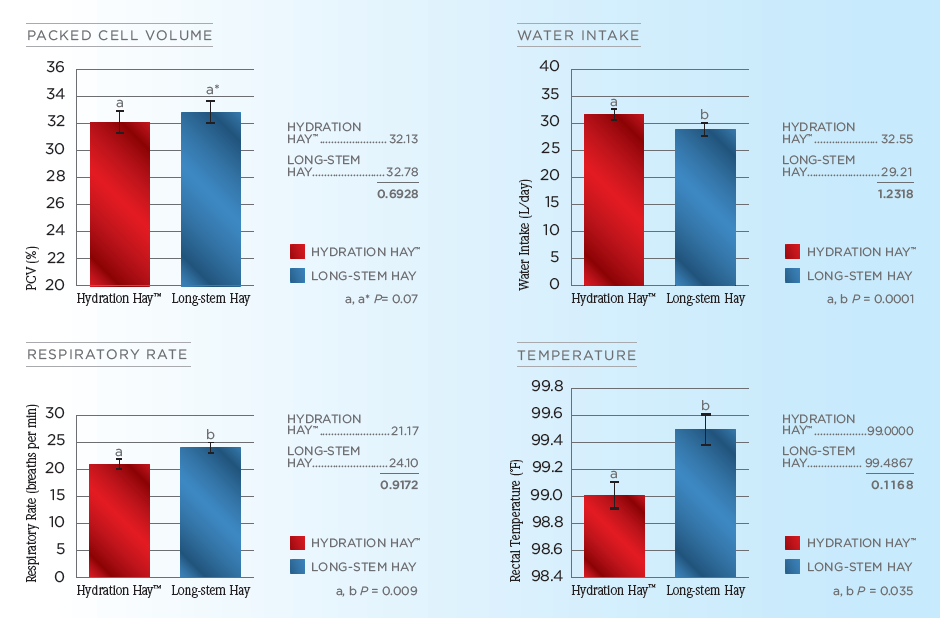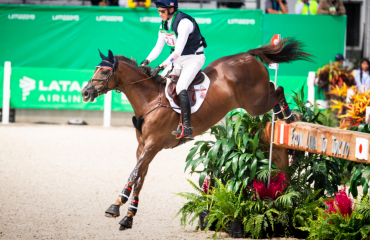Horses Offered Purina® Hydration Hay™ Blocks Demonstrated Improved Markers of Hydration Status During Transport
A SUMMARY OF PURINA ANIMAL NUTRITION SPONSORED RESEARCH1,2 CONDUCTED
AT TEXAS A&M UNIVERSITY COMMERCE EXAMINING THE HYDRATION STATUS OF
HORSES RECEIVING HYDRATION HAY™ BLOCKS VERSUS TYPICAL LONG-STEM HAY
DURING SUMMER TRANSPORT.
INTRODUCTION
The stress of transportation, especially during hot, humid weather conditions, can negatively impact horses’ health. Decreased water intake, heat stress, increased respiratory complications and other health difficulties can arise when horses are transported. Hydration Hay™ blocks are designed to soak up to 5L of water and conveniently provide quality forage along with hydration. This patented product can be offered to horses during trailering to help offset the potential deleterious effects of transport stress. This experiment was designed to test the hypothesis that horses trailered with access to Hydration Hay™ blocks would demonstrate improved markers in hydration status compared to horses with access to traditional dry hay.
MATERIALS AND METHODS
A randomized, crossover design was utilized with ten mature horses initially assigned to either Bermuda grass hay or
Hydration Hay™ block groups. Horses were transported on a commercial trailer and transported 721 km. One week later, horses were reassigned to opposite treatments and hauled a second time for 695 km. For both hauls, measurements of body weight and water intake were taken prior to and after the haul. Before, during and after transport, blood samples (glucose, total serum protein, packed cell volume, blood urea nitrogen and serum creatinine) and vital signs (heart rate, respiration rate, rectal temperature, skin turgor and capillary refill time) were taken. Data were analyzed using SAS PROC MIXED.
HORSE.PURINAMILLS.COM
©2013 PURINA ANIMAL NUTRITION LLC
RESULTS
Treatment did not affect (P>0.17) serum glucose, total serum protein, BUN, serum creatinine, or BUN:serum creatinine concentrations. Further, treatment did not affect (P_0.25) heart rate, percent bodyweight change, skin turgor or capillary refill time. For rectal temperature, a treatment Å~ haul interaction (P=0.03) was evident, where temperature was 0.25°C less (P<0.01) for horses receiving Hydration Hay™ during the first haul. However, rectal temperature was not different (P=0.16) during the second haul. Interestingly, mean environmental temperature was 6.1°C greater for Haul 1 compared to Haul 2. For horses receiving Hydration Hay™ blocks, there was a trend (P=0.07) for these horses to have a lower packed cell volume, and they also had lower (P<0.01) respiratory rates at the end of transport compared to horses offered traditional hay. Importantly, average overall water intake of horses receiving Hydration Hay™ blocks before, during and after transport was 3.3 L/d greater (P<0.01) than horses receiving dry hay.
IMPLICATIONS
In conclusion, for horses transported with Hydration Hay™ blocks, decreases in packed cell volume, respiratory rate, and rectal temperature during a high temperature haul pointed to improved hydration status. In addition, horses receiving Hydration Hay™ blocks before, during and after transportation had overall higher water intakes that can help to offset the stress and dehydration associated with trailering.
FOR MORE INF ORMATION
Please contact your local Purina representative if you would like more
information about this study.






